Suunto Ocean User Guide
Wireless tank pressure support
Suunto Ocean can be used together with Suunto Tank POD for wireless transmission of tank pressure and gas consumption to the dive computer. Suunto Ocean is only compatible with Suunto Tank POD transmitters. Suunto Tank POD transmits data using 123 kHz band. The communication from the Tank POD to the dive computer is one-way, meaning the dive computer does not send anything to the Tank POD.
Enabled features when Suunto Ocean is paired to Suunto Tank POD:
Tank pressure from up to 5 gas cylinders
Actual gas consumption for the active gas (L/min or cu ft/min)
Remaining gas time for the active gas
Configurable tank pressure alarms
Logging of start, end and the used pressure
Logging of average gas consumption for every gas with Tank POD
Units in bar or PSI
How to install and link a Suunto Tank POD
To install and link a Suunto Tank POD:
Install the Tank POD as described in the Tank POD quick guide or in the Tank POD user guide.
NOTE:To ensure the most accurate tank pressure readings, Suunto recommends that you install Suunto Tank POD so it is on the same side as you wear your Suunto Ocean.
- After installing the Tank POD and opening the valve, wait for the green LED on the Tank POD to flash.
- Go to the Tank POD menu under Dive options. If your Tank POD is active and in range you see the Tank POD serial number listed.
- Select the correct Tank POD and check its battery status and the tank pressure.
- Select the correct gas from the list to link with your Suunto Tank POD (if diving with multiple gases).
- Make sure the tank size is correct to enable correct gas consumption metering.
Go Back to the main menu and you will see your Tank POD serial number listed under the Tank POD menu.

Alternatively, you can link the Suunto Tank POD(s) from the Gases menu:
- In the Gases menu, select the gas you want your Tank POD to link with.
- Go to the Edit gas view and scroll to the Tank POD setting.
Make sure the Tank POD has been activated and that it is within range. Select your Tank POD serial number from the list.

If you have linked the same Tank POD to several gases, remember to check before your dive that you have the right active gas and that you have your Tank POD linked. In the dive main views, only one tank pressure is shown and corresponds to the active gas.
If there are several divers using Tank PODs, always check before you dive that the POD number of your selected gas corresponds to the serial number on your POD.
You can find the serial number on the metal base and also on the cover of the Tank POD.
Repeat the procedure above for additional Tank PODs and select different gases for each POD.
To unlink and remove your Tank POD from a specific gas:
Select the gas you want to remove the Tank POD from in the Gases menu.
De-select the Tank POD you want to remove (check the serial number).
Your Tank POD is removed from the selected gas list.
You can also unlink the Tank POD from the Tank POD menu.
You can only unlink your Tank POD once it is active and transmitting.
Always use a backup analog submersible pressure gauge as a redundant source of gas pressure information.
For Suunto Tank POD related information, please see the instructions provided with the product.
Tank pressure
Once your Suunto Ocean is linked to a Suunto Tank POD, you can follow the tank pressure both in the switch window and on the arch in the tank pressure view. See Key information during diving on how tank pressure is shown on the arch.
The following examples show different tank pressures:
Tank pressure is 125 bar:
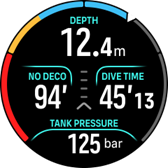
Tank pressure is 50 bar:
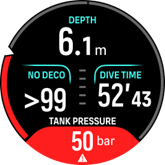
An extra tank pressure alarm is set to 100 bar:
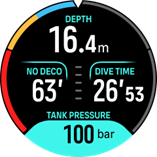
If you have not paired a Suunto Tank POD, the switch window tank pressure will read No Tank Pod. If A Tank POD is paired but no data is being received, the field shows - -. This may be because the POD is not in range, the tank is closed, or the POD battery is low.
LED lights may interfere with the Tank pressure signal.
Gas consumption
You can follow your actual gas pressure during your dive from the switch window on the watch screen. You can also see the average gas consumption from the dive in the dive summary in the device and in Suunto app.
The Gas consumption data on the screen refers to your real-time consumption rate of gas during a dive at the depth you are at. To calculate your personal breathing rate, Suunto Ocean uses respiratory minute volume (RMV) which is the volume of gas your lungs experience per minute, measured in L/min or cu ft/min. For accurate gas consumption, you need to define the correct tank size for the gas in the Edit gas menu. See Edit gas. The default tank size is always 12 L (80 cu ft) .
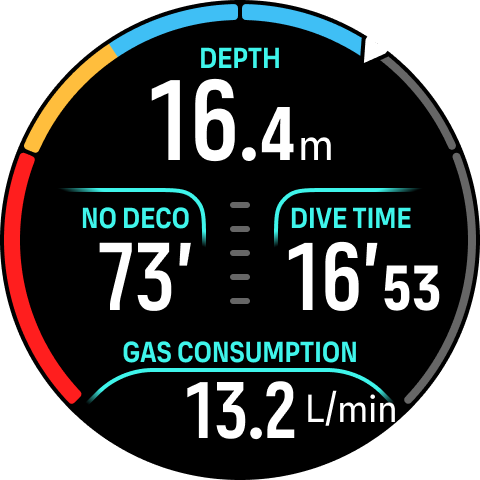
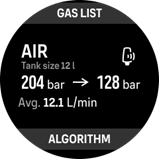
The RMV formula used in Suunto Ocean to calculate the gas consumption during the dive is the following:
The calculation is based on actual depth and the average used gas volume (in atmospheric pressure) calculated within in a varying 50 – 170-second window.

| Vgas (liters) | Gas volume in atmospheric pressure |
| RMVliters/minute | Depth compensated SAC |
| T1 | Time at the beginning of the window |
| T2 | Time at the end of the window |
| Depth (T) | Depth |
| VT1 | Vgas (liters) at the beginning of the window |
| VT2 | Vgas (liters) at the end of the window |
| Daverage | Average depth in time window |
To calculate gas volume, Suunto Ocean uses the following formula:

You can see your average gas consumption after the dive in the dive summary. The value shows the average gas consumption value, calculated from all the gas consumption values during the dive.
Since the real-time consumption values are based on data collected within a time window, the gas consumption value might not be populated immediately at the beginning of the dive. The values might also be higher due to using low pressure hose to control buoyancy in BCD or exposure suit.
The gas calculations also take into consideration the gas compressibility and temperature variations to provide more accurate values.
Gas time
The Gas time value in the switch window indicates the maximum time (in minutes) you can stay at the current depth and ascend to the surface (at an ascent rate of 10 m/min) with and end pressure of 35 bar (508 psi). The time is based on the tank pressure value, tank size and your current breathing rate and depth.
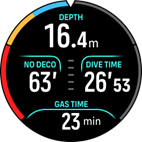
Gas time is calculated using the following formula:

Safety stops and decompression stops are not included in the Gas time calculations.